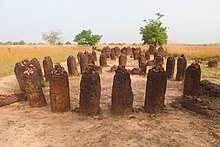Quarrying site of the stone circles of Wassu
The quarrying site of the Wassu Stone Circles has been identified as the quarry of the Wassu Stone Circles in Gambia . The mining site was placed on its tentative list by the Gambia in 2015 , a list of proposals to allow further sites to be recognized as possible world heritage sites. This entry is intended to be an extension of the Senegambian stone circles world heritage site .
description
The stone circles belong to the Senegambian stone circles and lie in a band around 100 kilometers wide and 350 kilometers long. They include more than a thousand monuments along the Gambia River in the West African states of Gambia and Senegal . In 2006 they were included in the UNESCO World Heritage Site . They are concentrated in four groups: Sine Ngayène, Wanar, Wassu and Kerr Batch. Similar stone circles are known in the south as far as Guinea .
The quarry is located on a laterite ridge east of the Wassu complex. The ridge is covered with grass and other vegetation that obscures the view of the ledge from a distance. The quarries are easy to identify because they were extracted from the stone in the open pit. The most noticeable shape is a columnar quarry where the stone was quarried and probably finished. Other shallow cuttings and stepped platforms also indicate quarrying activity, but can also indicate natural erosion . Some partially worked stones have remained in place. But they are broken, which probably led to their abandonment. The site is on the edge of the outcrop that hosted the removal of the stone from its matrix. Another quarry is to the southeast. The quarries do not seem to have been systematically exploited, but only to facilitate access to the raw material and the transport of the finished products.
From the visible remains in situ , the stones appear to have been quarried in blocks, as they occur naturally, and were then processed, presumably at the site of the quarry. The ridge is littered with broken stone fragments. The number of quarries does not reflect the size of the Wassu circles and their outliers, although the current plant cover does not allow an accurate estimate of the extent of the quarries.
The first important stage in the building process of the stone circles was the identification of suitable lateritic outcrops for the processing of the stones. Although laterite is widespread in the region, identification of compact and homogeneous outcrops with minimal natural weaknesses required a great deal of knowledge of the local geology. Without this expertise it would have been almost impossible to exploit the quarries from which the monoliths arose.
The second noteworthy aspect relates to the machining and dismantling of the monoliths. The dismantling and extraction of the monoliths caused great difficulties at that time. The monoliths that were broken and left in place, especially in the Wassu quarry, often show traces of microscopic cracks or different ferrous coatings that could have caused their splitting during the process. Consequently, it took considerable technical skills and a good knowledge of the raw material to achieve the required size of the monoliths and to extract them accordingly.
The transport and installation of the monoliths on the other hand, judging by the distances between the quarries and the storages, requires a well-founded social organization in order to mobilize the huge workforce that is responsible for the transport and storage of the laterite blocks, which in some cases could weigh up to seven tons are required.
The quarries near the Wassu Stone Circles are proven to be the source of most of the stones used on the Wassu Circle site. The quarry site, the references to different mining methods as well as the adjacent grinding groves, which were used to sharpen the iron tools required for the mining, complete the Wassu site and the megalithic complex in general, adding to our knowledge of the process of making the monoliths and the Load during transport to the installation site for assembly expanded. The quarry also speaks to the iron-working tradition of the society responsible for constructing the megalithic phenomena and their amazing knowledge of local geology.
The quarry in Wassu shows a high degree of authenticity. First, the site is on the laterite hill from which the stones at the Wassu site were quarried. Aside from the presence of stones that were broken during the quarrying or transportation process and abandoned on the site, there are also indications of the various possible mining methods. In place are also the grinding groves, which provide insight into how they were used to sharpen the iron tools that were essential for the mining process.
Although stone circles can be found in many parts of the world, they are not made from laterite anywhere. In addition, the origins of the stones in most of the other surviving circles, including the circles at Stonehenge , are also speculative. The Wassu quarry is located in the immediate vicinity of the site of the Wassu stone circles and provides indisputable evidence of the origin of the Wassu stones, as it differs from other sites in the circle, some of which are more than 20 kilometers away.
Web links
- Wassu Stone Circles Quarry Site on the UNESCO World Heritage Center website for tentative lists.
Individual evidence
- ↑ a b c d e f g h i Wassu Stone Circles Quarry Site. In: whc.unesco.org. UNESCO World Heritage Center, accessed July 30, 2020 .
Coordinates: 13 ° 41 ′ 45.1 ″ N , 14 ° 51 ′ 32.7 ″ W.

